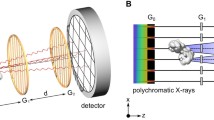Summary
This is the first reported use of low-angle X-ray scattering for the investigation of urinary calculi. Low-angle X-ray scattering (LAXS) measures the diffraction of a broad spectrum of X-rays at a single angle and uses a conventional diagnostic X-ray beam, and could thus be developed for use in vivo. A total of 45 calculi were investigated using this technique. Calcium oxalate stones showed a bimodal signature with peaks of almost even photon energies. Signatures for the other stone types were less well-defined. The results are discussed in more detail below. Our preliminary results show that the technique is capable of distinguishing between calcium oxalate stones and other stone types in vitro. Further work is in progress to correlate the results of this technique with objective parameters of stone hardness.
Similar content being viewed by others
References
Bellanato J (1990) Infrared spectroscopy of urinary calculi. In: Wickham JEA, Buck AC (eds) Renal tract stone. Metabolic basis and clinical management. Churchill Livingstone, Edinburgh, pp 45–58
Cohen NP, Parkhouse H, Scott ML, et al (1992) Prediction of response to lithotripsy — the use of scanning electron microscopy and x-ray energy dispersive spectroscopy. Br J Urol 70:469–473
Dyer RB, Zagoria RJ (1992) Radiological patterns of mineralisation as predictor of urinary stone aetiology, associated pathology, and therapeutic outcome. J Stone Dis 4:272–282
Johnson LN (1985) Protein crystallography. In: Neuberger A, VanDeenen LLM (eds) Modern physical methods in biochemistry. Elsevier, Amsterdam, pp 347–408
Leusmann DB, Blaschke R, Schmandt W (1990) Results of 5035 stone analyses: a contribution to epidemiology of urinary stone disease. Scand J Urol Nephrol 24:205–210
Royle GJ, Speller RD (1991) Low angle x-ray scattering for bone analysis. Phys Med Biol 36:383–389
Speller RD, Horrocks JA (1991) Photon scattering — a “new” source of information in medicine and biology? Phys Med Biol 36:1–6
Speller RD, Horrocks JA, Lacey R (1993) X-ray scattering signatures for material identification. SPIE Proc 2092:366–377
Sutor DJ (1982) X-ray diffraction analysis of urinary calculi. In: Rose GA (ed) Urinary stones: clinical and laboratory aspects. MTP, Lancaster, England, pp 107–134
Sutor DJ (1990) The nature of urinary stones and their analysis. In: Wickham JEA, Buck AC (eds) Renal tract stone. Metabolic basis and clinical management. Churchill Livingstone, Edinburgh, pp 29–37
Wandt MA, Rodgers AL (1988) Quantitative X-ray diffraction analysis of urinary calculi by use of the internal standard method and reference intensity ratios. Clin Chem 34:289–293
Author information
Authors and Affiliations
Rights and permissions
About this article
Cite this article
Dawson, C., Horrocks, J.A., Kwong, R. et al. Low-angle X-ray scattering signatures of urinary calculi. World J Urol 14, S43–S47 (1996). https://doi.org/10.1007/BF00182064
Issue Date:
DOI: https://doi.org/10.1007/BF00182064




